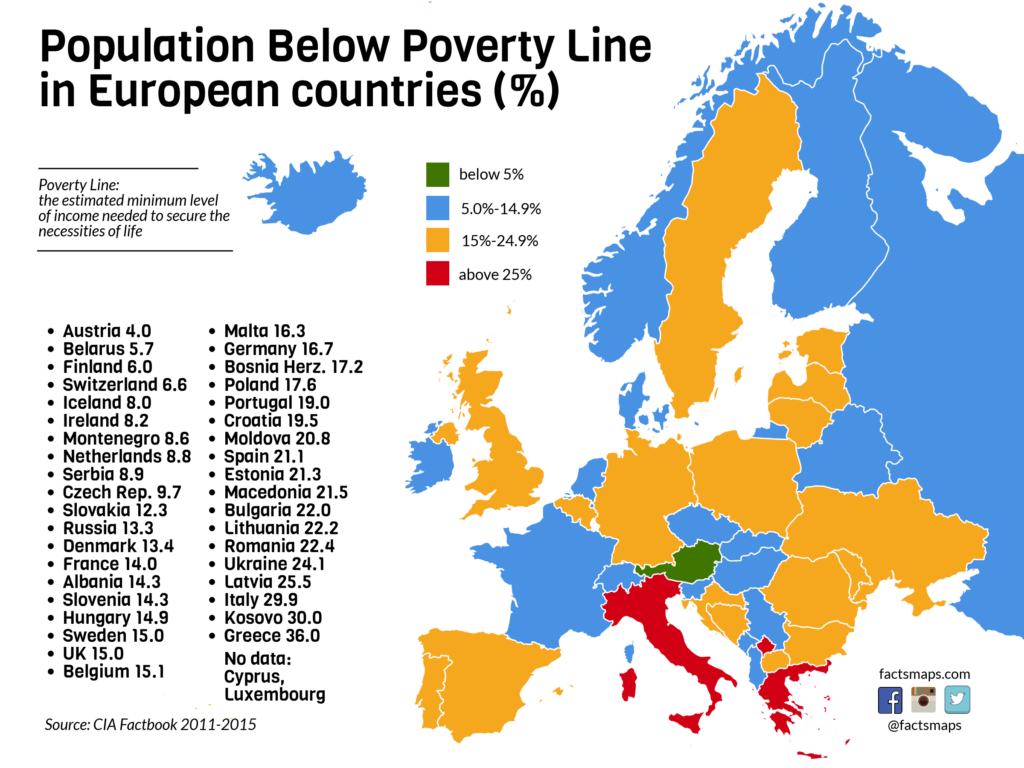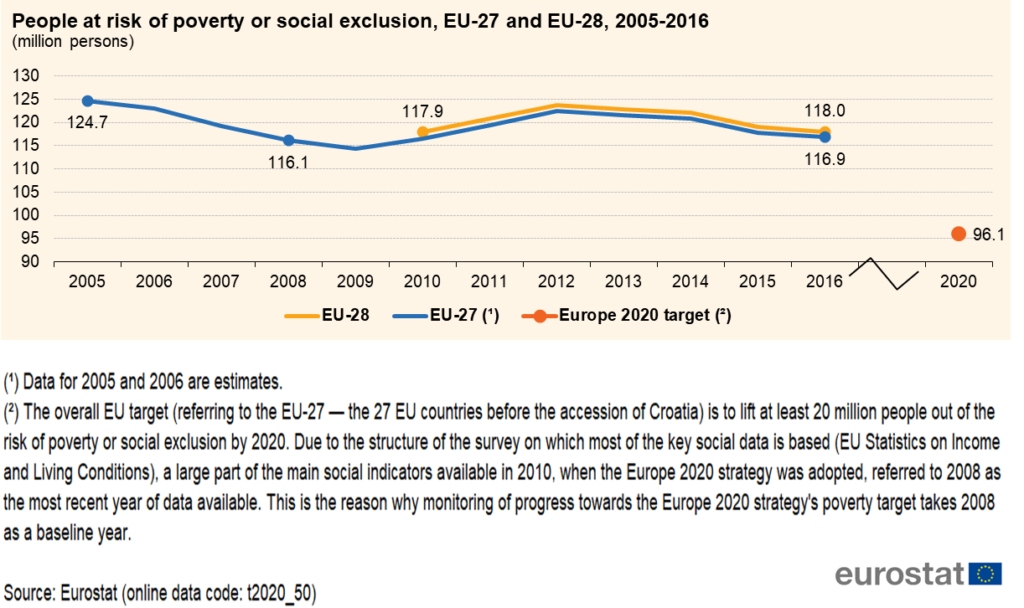Europe 2020 indicators – poverty and social exclusion among Pentecostals
Europe 2020 indicators – poverty and social exclusion
In 2019, the number of people at risk of poverty or social exclusion in the EU was still higher than in 2008, although the Europe 2020 target is to reduce by 20 million by 2020.
8 Poorest Countries In Europe:
- Kosovo –
- Albania – …
- Bosnia and Herzegovina – …
- Republic of Macedonia – …
- Serbia – …
- Belarus – …
- Montenegro…
- Bulgaria
12 Facts About Poverty in Europe
-
- One in four Europeans experiences at least one form of poverty. Forms of poverty include income poverty, severe material deprivation, very low work intensity and social exclusion. Income poverty is the most common form of poverty in Europe, affecting 17.3 percent of people. One hundred eighteen million people (23.5 percent) of the EU-28 population were at risk of poverty or social exclusion, with 43 million of those not able to afford a quality meal every second day. This is known as severe material deprivation.
- Social exclusion is the lack of social resources and rights available to most people as a result of poverty or being part of a minority group. In 2015, more than a third of the population was at risk of poverty or social exclusion in three EU countries:
41.3% in Bulgaria,
37% in Romania and
35.7% in Greece.
The countries with the lowest risk were the Czech Republic at 14% and Sweden at 16%.
- The poverty line is the minimum level of income needed to secure the necessities of life and differs greatly for each European country. An average of 9.8 percent of people in the EU live below the poverty line. The country with the lowest amount of people living below the poverty line is Austria at four percent, and the highest is Greece at 36 percent. This is one of the 12 facts about poverty in Europe that reveals the enormous gap between wealthier and poorer countries in Europe.
- The unemployment rate in Europe is only around seven percent. According to Eurostat, some countries rank above this average with Greece at 20.9 percent and Spain at 16.3 percent. In 2016, 48.7 percent of people who were unemployed were at risk of poverty. Unemployment also makes people more at risk of severe material deprivation.
- Poverty in Europe is not limited to those who are unemployed. In 2015, 7.7 percent of the EU population was at risk of poverty despite working full-time, with men more at risk than women. Romania has Europe’s highest risk of in-work poverty with a rate of 18.9 percent. Spain and Greece follow with 13.1 percent and 14.1 percent, respectively. Additionally, the in-work poverty risk has increased from 8.3 percent in 2010 to 9.6 percent in 2016.
- Women have a higher risk of poverty in Europe. The number of women suffering from poverty or social exclusion in the EU was 1.9 percent higher than men in 2015. Additionally, young people between the ages of 18 and 24 are more at risk of poverty or social inclusion with a risk of 30.6 percent.
- In 2015, almost 50 percent of all single parents in Europe were at risk of poverty or social exclusion, which is twice as much as the risk for any other household.
- Foreigner-born residents (39.2 percent) are at a higher risk of poverty or social exclusion than native citizens (21.6 percent). In Italy, the number of foreigners at risk is particularly high at 55 percent.
- Children below the age of 18 also have a high rate of poverty or social exclusion, at 47 percent, with 26 million children in the EU living at risk of poverty or social exclusion. Child poverty in the U.K. has reached its highest level since 2010, reaching 30 percent.
- Even with the economy improving, one in three people in Spain still lives in poverty, which is defined as living on €8,000 or less per year. Children are also at a higher risk of poverty in Spain. In Andalusia, a Spanish province, child poverty reached 44 percent.
- Italy has the most people at risk of poverty in Europe. This amount rose from 15 million to 18 million people since the 2008 crisis, with over 4 million people living in absolute poverty.
- The heads of government in the EU adopted the Europe 2020 Strategy in 2010 to address poverty. The goal of this was to lift at least 20 million people out of the risk of poverty and social exclusion by 2020. Unfortunately, this goal has not been reached and the situation has gotten worse instead of better. There has been an increase in poverty in the EU over the past years. In 2009, there were 117 million people and 27 EU member states at risk of poverty or social inclusion in the EU Since then, there has been an increase of 1.6 million people and one country.
Although these 12 facts about poverty in Europe may introduce a growing problem, the EU along with the European governments are taking active steps to fight this problem. Several countries’ economies are now expanding and showing improvement since the crisis. This includes Spain’s economy, which now has a predicted growth of 2.5 percent in 2018. It is imperative to continue to provide foreign aid and assistance in order to ensure that U.S. allies continue to grow and move past the repercussions suffered after the crisis.










Comments